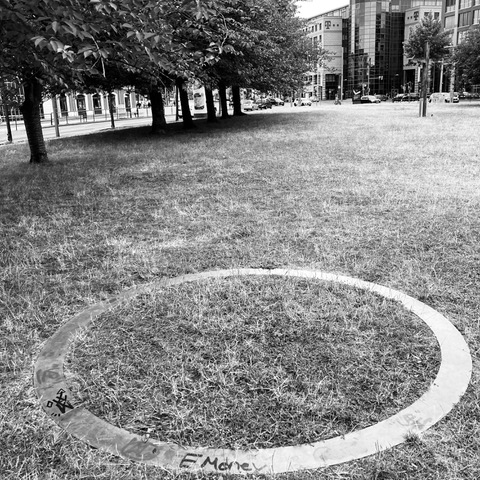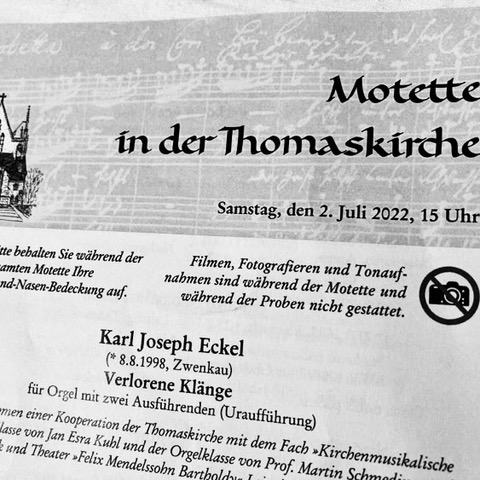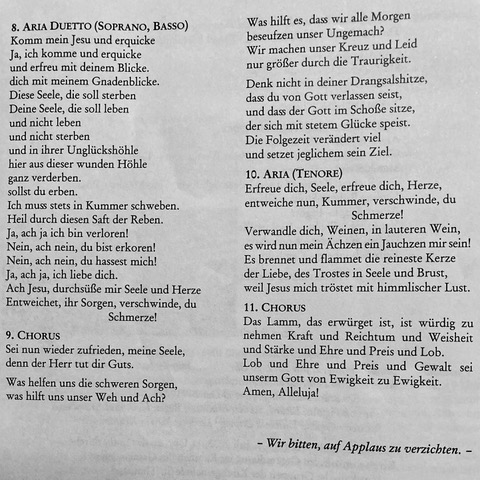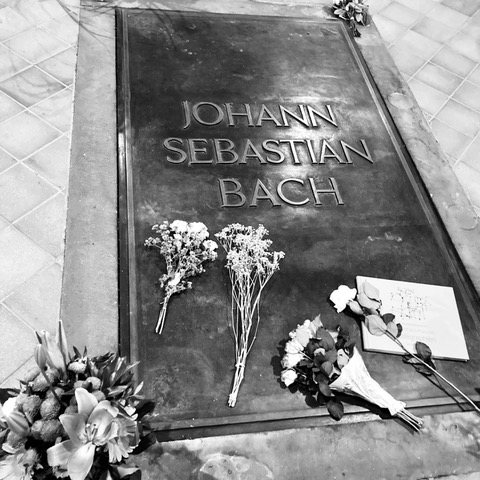By Tom Plovie
Reportage
‘IN DE VOETSPOREN VAN BACH’
EEN MUZIKALE PELGRIMAGE IN THÜRINGEN & LEIPZIG (NL)
Sei nun wieder zufrieden, meine Seele,
denn der Herr tut dir Guts.
Was helfen uns die schweren Sorgen,
was hilft uns unser Weh und Ach?
Was hilft es, dass wir alle Morgen
beseufzen unser Ungemach?
Wir machen unser Kreuz und Leid
nur größer durch die Traurigkeit.
Denk nicht in deiner Drangsalshitze,
dass du von Gott verlassen seist,
und dass der Gott im Schoße sitze,
der sich mit stetem Glücke speist.
Die Folgezeit verändert viel
und setzet jeglichem sein Ziel.
Cantata ‘Ich hatte viel Bekümmernis’ (BWV 21) 9. chorus
from Bach: Cantates, vol 2 – John Eliot Gardiner
In de zomer van 2020 wilde ik een reis doen waar ik al lang van sprak. Land van bestemming: Duitsland. Te bezoeken: de deelstaat Thüringen en de stad Leipzig (in Saksen). Doel van de reis: ‘In de voetsporen treden van Bach’, ofwel: enkele plaatsen bezoeken waar hij woonde en werkte. En met ‘Bach’ bedoel ik Johann Sebastian Bach (1685-1750), want de Bach-familie kende veel muzikanten. De reis werd gepland maar kon door de pandemie niet doorgaan. Ook niet in 2021. Uiteindelijk vertrok ik eind juni 2022 naar Duitsland met als eerste stop de stad Eisenach: de geboorteplaats van Bach.
Waarom Bach en wat betekent hij voor mij? In één woord: troost. Daarnaast zorgt zijn muziek ook voor rust, en voel ik vaak ontzag. Hoe één mens, in de omstandigheden van zijn tijd, zo’n fenomenale muziek kon schrijven (waarvan veel verloren is gegaan) blijft onvoorstelbaar. ‘In de omstandigheden van zijn tijd’? Wel: hij werd wees op zijn 10de, de helft van zijn 20 kinderen werd niet volwassen, zijn eerste vrouw overleed voor ze 40 werd, de relatie met zijn opdrachtgevers was vaak vertroebeld en de werkdruk lag fenomenaal hoog – om het even vlug te schetsen. Gelukkig ging dat niet ten koste van zijn creativiteit of de superbe kwaliteit van de muziek. Ontzag dus.
Eisenach. Het geboortehuis van Bach is tevens het Bachmuseum. Op maandagvoormiddag naar een museum gaan heeft als voordeel dat je dat in alle rust kunt doen. De tuin lag er prachtig bloemig bij en de paadjes netjes geharkt. De zachte zomerzon gaf alles extra kleur. Heerlijk vond ik dat. Maar toch knaagde er iets. Om Bach tastbaar te maken keek ik uit naar authentieke stukken: van hem of zijn hand. En dat viel best tegen. Zowat alles in het huis was wel ‘uit die tijd’, maar niet meteen ‘van hem’ of zijn ouders. Ik vond alsnog één zwak verlichte originele partituur in de collectie. Verwachtingen werden bijgesteld. Wat ‘het geboortehuis’ betreft, was ik beter voorbereid. Het museum zou dan toch niet het geboortehuis van de grote Bach zijn! Op basis van fiscale bronnen wordt tegenwoordig gekeken naar het donkergrijze huis (nr. 35) in de straat er tegenover. Eén zekerheid blijf overeind: we weten bijzonder weinig van Bach, de mens van vlees en bloed. Desnalniettemen was er een fijn surplus van dit bezoek: het live concert dat er elk uur wordt gehouden. En deze keer was dat voor ons alleen! Ik mocht zelfs even ‘meespelen’ door de pijpen van een oud orgel al pompend met de voet van lucht te voorzien. Op de spinet werd de eerste prelude uit ‘Das wohltemperierte Klavier’ (BWV 846) gespeeld. Dat is het enige stuk wat ik uit dat werk kan spelen. Herkenbaar dus en heerlijk om horen én mee te maken.

Mijn eerste kennismaking met Bach? Vermoedelijk is die gelinkt aan de Walt Disney-film ‘Fantasia’ (1940). Ik herinner me de LP levendig die mijn vader had. De bekende ‘Toccata en Fuga in d-moll’ (BWV 565) kreeg er een grote rol, al werd ze niet op orgel gespeeld maar in een versie met groot romantisch orkest. Dat maakte indruk! Mijn smaak in uitvoeringen is ondertussen gewijzigd. De versie op orgel van Helmut Walcha is een terechte standaard geworden. Maar de échte liefde voor de componist kwam er pas door mijn pianoleraar Robert H. Hij wist mij, toen ik als 22-jarige met pianoles begon, jarenlang te voeden met zowel muzikale als technische inzichten over het werk van JSB. Na 15 jaar les bij hem overleed Robert onverwacht in 2018. Toen ik postuum zijn pianoversie van de bekende Chaconne (BWV 1004) te horen kreeg, was dat troost in zijn puurste vorm. Wat een geschenk om die opname toevertrouwd te krijgen.
Weimar is een bijzonder aangenaam en groen stadje in het hart van Thüringen. Bach componeerde er vooral orgelwerken en maakte furore als klaviervirtuoos (1708-1717). Aan het hof werd hij concertmeester. Helaas werd dat hertogelijk hof gekenmerkt door intern gekibbel. Na enkele jaren vond Bach dat het tijd werd om andere oorden op te zoeken. Het vorstendom van Kötchen leek hem ideaal. Maar zijn ontslag werd niet zomaar aanvaard. De regerende hertog gooide hem een maand lang de gevangenis in. Wat dacht hij wel? Die ‘gevangenis’ kan je vandaag gewoon bezoeken in het Stadslot (de bastille). Helaas viel de eigenlijke plaats van isolement er niet te achterhalen. Jammer.
Ik ben graag voorbereid. Dat gaat ten koste van spontaniteit maar biedt wel een rijkdom aan extra beleving. Vooraleer naar een klassiek concert of opera te gaan, luister ik graag op voorhand naar de muziek. Ik laat het zich dan rustig nestelen in mijn gehoor. Via een streamingdienst lukt dat vlotjes en tijd is er ook voldoende door het vele thuiswerken. Voor mijn bezoek aan Leipzig keek ik de concerten na – kwestie van te weten waar naar te luisteren. Vooral die in de Thomaskirche trokken mijn aandacht. Dat is dé plaats waar Bach 27 jaar had gemusiceerd en waar hij ook begraven ligt – althans de overblijfselen waarvan men denkt dat het de grootmeester is. Altijd maar mysterie en ongrijpbaarheid.
Tijdens dat voorbereidend werk leerde ik om niet van een ‘concert’ te spreken maar van een ‘motette’. Er zou de zaterdagnamiddag van mijn gepland bezoek een heuse cantate worden gespeeld. Dat is een compositie van 20 à 40 minuten voor zang en instrumenten. Bach schreef er zo’n 200-tal, althans diegenen die niet verloren zijn gegaan. BWV 21 (‘Bach Werke Verzeichnis’, de catalogusnummering) stond op de agenda: de religieuze cantate ‘Ich hatte viel Bekümmernis’. Mijn goede voornemens ten spijt beluisterde ik deze cantate (in 11 delen!) slechts éénmaal op voorhand, hetgeen te weinig bleek om herkenning op te roepen. Dan maar terugvallen op spontaniteit. En hoe!
We arriveerden op vrijdag in Leipzig. Het weer was grijs en nat. Ideaal om een tweede Bachmuseum te doen. Ze is gehuisvest tegenover de plaats waar Bach, als cantor, vroeger woonde: de Thomasschule. Deze school bestaat sedert 1212 en betreft een jongenskostschool. Richard Wagner is één van de bekendste oud-studenten, net als enkele zonen van Bach. Het was opnieuw een rustig bezoekmoment en aangenaam vertoeven in het museum. Daarna wou ik alsnog de ‘originele’ begraafplaats van Bach zien, te vinden op het Alter Johannisfriedhof. Zijn vermeende overblijfselen werden er in 1894 opgegraven en vervolgens herbegraven, vooraan in de Thomaskirche. Op de plaats van opgraving, een verloren ogend graspleintje, is enkel een tekstloze cirkel te zien. Toch vond ik het een ommetje waard want ja, misschien ligt de échte JSB er nog steeds – op enkele meters rondom de plaats waar ik stond?

Het beroemde Thomanerchor live horen is een belevenis. Ik besloot om die avond al naar de Thomaskirche af te zakken. Immers, ook op vrijdag is er een wekelijkse motette en we hadden er de ruimte voor. Reserveren is niet mogelijk en we waren mooi op tijd. Het blijft een kerk en de motette is in zeker zin ‘een dienst’ (met preek!) en dus geen optreden. Stipt om 18 uur stapten de jongens in duo en met stevige tred de kerk binnen. Vooraan vonden ze hun vaste plaats en kon de motette van start gaan. De oudere studenten van het koor dirigeerden die avond zelf. Ook dat hoort bij hun opleiding. Er werd een afwisselend programma gebracht: van instrumentaal tot gezongen, van barok tot hedendaagse muziek en er was zelfs improvisatie op het orgel. Van Bach werd enkel de beroemde Air uit BWV 1068/2 gespeeld, in een arrangement voor koor. Applaudisseren werd niet gedaan (zoals gevraagd in het programma). Opnieuw: dit is geen concert, hetgeen de ervaring alleen maar mystieker maakte.
Ik reisde niet alleen en de plannen voor de zaterdag werden gewijzigd. Het werd een stralende zomerdag en niet alles hoefde in het teken van Bach te staan. Ik had de avond ervoor al een motette in de Thomaskirche mogen meemaken. ‘s Voormiddags bezochten we een tentoonstelling en nadien lunchten we, zonder tijdsdruk, op een zonnig terras aan de waterkant. Na een aangename wandeling in het park stonden we plots, enkele minuten voor 15 uur, aan de achterzijde van de Thomaskirche. Gaf het toeval mij toch een duwtje om de cantate bij te wonen? Spontaniteit werd beloond en ik dook, deze keer alleen, opnieuw de kerk in.

Die namiddag stond er geen koor vooraan maar bevonden de musici zich achteraan de kerk, voor het orgel. Opnieuw zat de Thomaskirche afgeladen vol. Dat de cantate nog niet in mijn gehoor lag was niet erg, want zo valt de muziek op een ongedwongen manier op. Zo gebeurde het dat ik volledig onder de indruk was van het koorstuk ‘Sei nun wieder zufrieden’. Oh, de ervaring van livemuziek! Hoe al die stemmen wondermooi met elkaar vervlechten en toch zo in evenwicht kunnen blijven. Wat een beleving. En toen besefte ik het… Bach moet je blijven zoeken én vinden in zijn muziek. Een connectie willen maken door halsstarrig te focussen op fysieke objecten of plaatsen brengt niet veel op. De muzikale en emotionele beleving tijdens die live-ervaring is het dichtst wat ik bij Bach kon komen. Foto’s vallen er niet van te nemen. De mooiste herinneringen blijven in het hart hangen en hoeven geen beelden om aan vast te houden. Toen de stilte viel na het stevige slotstuk (vol barokke halleluja’s!) en er geen applaus volgde, voelde ik alleen maar dankbaarheid.
Later die avond, toen ik Messenger opende, werd mijn Bachbeleving compleet. Ik ontving een berichtje van E., de dochter van mijn pianoleraar. Enkele maanden eerder, op zijn verjaardag, stuurde ik haar een bericht als steun en medeleven. Zo’n dag roept herinneringen op en passeert niet zomaar. Ze excuseerde zich voor haar late antwoord en wou alsnog die avond reageren. Het was 2 juli. En die datum kende ik, maar had de connectie eerder die dag niet gemaakt.
Toen de muziek, die namiddag in de Thomaskirche, plaatsmaakte voor de Duitse preek dwaalde mijn gedachten af. Ik moest denken aan diegenen die er niet meer zijn en met wie ik graag over deze ervaring had willen vertellen. Eén van die mensen was mijn pianoleraar. Ik blijf dankbaar om nog steeds zijn liefde voor Bach te voelen en ze ook zelf te ervaren. E. herinnerde me eraan: het was dag-op-dag 4 jaar geleden dat haar vader afscheid nam van het leven. Ik pakte mijn smartphone en oortjes en zocht ‘BWV 21’ op. Ik scrolde naar het 9de deel: het koorstuk uit de cantate dat mij live zo had ontroerd. Bach brengt troost, altijd weer.


‘FOLLOWING IN THE FOOTSTEPS OF BACH’
A MUSICAL PILGRIMAGE IN THURINGIA & LEIPZIG
/. English version
Sei nun wieder zufrieden, meine Seele,
denn der Herr tut dir Guts.
Was helfen uns die schweren Sorgen,
was hilft uns unser Weh und Ach?
Was hilft es, dass wir alle Morgen
beseufzen unser Ungemach?
Wir machen unser Kreuz und Leid
nur größer durch die Traurigkeit.
Denk nicht in deiner Drangsalshitze,
dass du von Gott verlassen seist,
und dass der Gott im Schoße sitze,
der sich mit stetem Glücke speist.
Die Folgezeit verändert viel
und setzet jeglichem sein Ziel.
Cantata ‘Ich hatte viel Bekümmernis’ (BWV 21) 9. chorus
from Bach: Cantates, vol 2 – John Eliot Gardiner
In the summer of 2020, I wanted to go on a trip that I’ve been talking about for a while. Country of destination: Germany. To visit: the Free State of Thuringia and the city of Leipzig (in Saxony). The purpose of the journey: ‘Following in the footsteps of Bach’, or: visiting a few places where he lived and worked. And by ‘Bach’ I mean Johann Sebastian Bach (1685-1750), because the Bach family knew many musicians. The trip was scheduled but was unable to continue due to the pandemic. And not in 2021 either. Finally, at the end of June 2022 I set off for Germany with the first stop in the city of Eisenach: the birthplace of Bach.
Why Bach and what does he represent for me? In one word: consolation. In addition to this, his music also gives me peace and tranquility. Also: he impresses me many times. How a person, under the circumstances of his time, could write such incredible music (much has been lost) remains incredible. ‘Under the circumstances of his time’? Well: he became an orphan when he was 10 years old, half of his 20 children did not grow up, his first wife died before she became 40, the relationship with his employers was often muddled and the workload was phenomenal – to make a quick sketch. Fortunately, that was not at the expense of his creativity or the superb quality of his music.
Eisenach. The house in which Bach was born is also the Bach Museum (…). The great thing about going to a museum on Monday morning is that you can do it in total peace. The garden was beautifully flowered and the paths were neatly raked. The gentle summer sun gave all the extra colour. I loved that. And yet something became quite clear. To make Bach tangible, I searched for authentic pieces: by him or by his hand. However, I was disappointed. Almost everything in the house was ‘from that time’, but not immediately ‘from him’ or his parents. I did found one (!) faintly illuminated original score in the collection. Expectations were adjusted. As far as ‘place of birth’ is concerned, I was more prepared. The museum is not exactly the real birth house of the great Bach… According to tax sources, the dark gray house (no. 35) in the street in front of the museum should be the one. It should be clear that one certainty remains: we know very few things about Bach, the man of flesh and blood. Nonetheless there was a nice surplus of this visit: the live concert that takes place every hour. This time it was a private concert! They even allowed me to ‘play allong’ by pumping air with my foot into an old organ. The first prelude from ‘Das wohltemperierte Klavier’ (BWV 846) was played on the spinet. This is the one piece of that work I can play myself. So it was both recognisable and wonderful to hear and experience.

My first intro to Bach? That is probably related to the ‘Fantasia’ film, made by Walt Disney (1940). I remember my father’s LP very vividly. The well-known ‘Toccata and Fuga in d-moll’ (BWV 565) played a big part in it, although it was not played on organ but in a version with a large romantic orchestra. That made quite an impression! Meanwhile, my taste in performance has shifted. The organ version of Helmut Walsha is a valid standard. But the real love for the composer came by my piano teacher Robert H. When I started piano classes, at the age of 22, he introduced me for years in Bach’s music with musical and technical insights. After studying with him for 15 years, Robert suddenly passed away in 2018. When I listened posthumously to his piano version of the well-known Chaconne (BWV 1004), it was a consolation in its purest form. What a gift to receive this recording.
Weimar is a lovely and green city in the heart of Thuringia. Bach composed mainly organ pieces there and was a virtuoso of the keyboard (1708-1717). At the court he became a concert master. Unfortunately, that ducal court was characterized by internal squabbles. After several years Bach thought it was time to look for other places to work. The principality of Kötchen seemed perfect to him. But his resignation was not simply accepted. The ruling duke threw him into prison for a month. What was he thinking? You can still visit that ‘prison’ in Schloss Weimar (the bastille) today. Unfortunately, the actual location of isolation was not to be found there. Too bad.
I like to be prepared. Sometimes that comes at the expense of spontaneity, but it provides a great deal of additional experience too. Prior to attending a classical concert or opera, I like to listen to the music beforehand.
This benefits recognizability during the live experience. With a streaming service that is easy to do, and there is plenty of time to listen as a result of working from home. Before my visit to Leipzig, I looked out for the concerts. Especially the performances in the Thomaskirche attracted my attention. That is the place where Bach had been performing for 27 years and where he is buried – at least the remains we think are from the master. Again and again the mystery and the elusive.
During this preparatory work, I learned not to talk about ‘concert’ but ‘motette’. There would be a cantata to be played on the Saturday afternoon of my expected visit. A cantata is a composition of 20-40 minutes for vocals and instruments. Bach wrote about 200 of them, at least the cantatas that did not get lost. BWV 21 (‘Bach Werke Verzeichnis’, catalogue listing) was scheduled to take place that afternoon. That is the religious cantata ‘Ich hatte viel Bekümmernis’. Despite my good intentions, I only heard this cantata (in 11 parts!) once in advance, which turned out to be too little to recall recognition. Then let’s get back to spontaneity. And how!
We got into Leipzig on Friday. It was cloudy and rainy. Ideal to visit another Bach museum. It is located opposite the place where Bach, as a cantor, lived: the Thomasschule. This school has been in existence since 1212 and is a boys boarding school. Richard Wagner is one of the more famous alumni, as well as some sons of Bach. It was again a quiet visit and nice stay at the museum. Later on, I wanted to see Bach’s ‘original’ burial site, which can be found at the Alter Johannisfriedhof. His presumed remains were excavated in 1894 and then buried beneath the altar of the Thomaskirche. At the excavation site, a lost looking park in the city, only a circle without text can be seen. Yet I thought it was worth researching and visiting the place: perhaps the real JSB is still buried there, only a few metres from where I was standing?

To hear the celebrated Thomanerchor live is a whole experience. I decided, on the spot, to visit the Thomaskirche that evening. Every Friday there is also a weekly motette and we had time to attend it. It is not possible to make a reservation, but we were on schedule. It still remains a church and the motette is in a sense ‘a service’ (with sermon!) and so no ‘performance’. At 6 p.m., the boys of the choir walked side by side from the rear to the front of the church. The motette could begin. The senior students in the choir conducted that night. That’s part of the training as well. The program was diverse: from instrumental to vocal, from baroque to contemporary music and there was even improvisation on the organ. The only composition played from Bach was the famous Air from BWV 1068/2, in an arrangement for choir. No applause took place (as requested in the programme). I repeat: this is not a concert, which has only made the experience more mystical.
I didn’t travel by myself and Saturday’s plans had changed. It would be a nice summer day and our trip was not only about Bach. I already had the opportunity to experience a motette in the Thomaskirche the night before. In the morning we visited an exhibition and then we had lunch on a sunny terrace on the riverbank. After an enjoyable walk through the park, we suddenly stood – a few minutes before 3 p.m. – behind the Thomaskirche. Coincidence has led me to cantata. Spontaneity was rewarded in the end and this time I went to church by myself.

That afternoon, there was no choir in the front of the church. The musicians were at the back by the organ. Once again the Thomaskirche was packed. That I hadn’t listened to the cantata enough in advance wasn’t a bad thing. In that sense, the music itself might arise spontaneously. And that’s how I was totally impressed by the choral piece ‘Sei nun wieder zufrieden’. Oh, the experience of live music! Hearing how all of those voices can be wonderfully interwoven in such a balanced way: simply mesmerizing. And then I realised something… You have to keep looking for Bach in his music. Creating a connection through stubborn focus on physical objects or spaces is a waste of energy. The musical and emotional experience of a live performance is the closest I could come to Bach. You can’t get photos of that. The most beautiful memories must be kept in the heart and require no pictures. When the silence fell after the final and very baroque choral piece (full of hallelujas!) there wasn’t any applause. I felt nothing but gratitude.
Later in the evening, when I opened Messenger, my Bach experience was complete. I received a text from E., my piano teacher’s daughter. A couple of months ago, on his birthday, I sent a message of support and compassion. A day like that brings back memories and cannot simply pass. She apologized for the late response and wanted to reply the same evening. It was July 2. I knew the date, but I did not make the connection earlier today.
When the music, that afternoon in the Thomaskirche, had to make way for the German sermon, my thoughts went astray. I thought of those who are no longer with us and with whom I wanted to talk about this experience. One of them was my piano teacher. I remain thankful that I still feel his love for Bach and now feel it myself. E. reminded me that her father died precisely four years ago. I took my smart phone and headphones and looked up ‘BWV 21’. I scrolled to the 9th part: the choir piece of the cantata that touched me so much. Bach always comes with consolation.


Tags
Reportage
Johann Sebastian Bach
St. Thomas Kirche
Leipzig
Germany
Classical Music
Author
Tom Plovie - Lokeren, 14 juli 2022
Sources
Thomas Kirche LeipzigArtist
Johann Sebastian Bach
